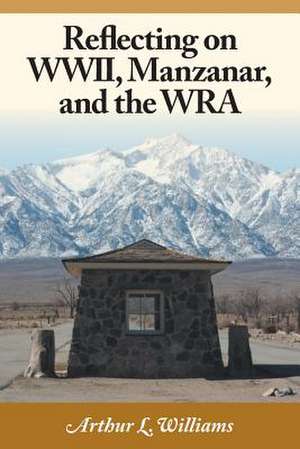Reflecting on WWII, Manzanar, and the Wra
Autor Arthur L. Williamsen Limba Engleză Paperback – 4 mai 2014
| Toate formatele și edițiile | Preț | Express |
|---|---|---|
| Paperback (1) | 137.32 lei 3-5 săpt. | |
| Friesenpress – 4 mai 2014 | 137.32 lei 3-5 săpt. | |
| Hardback (1) | 209.61 lei 3-5 săpt. | |
| Friesenpress – 4 mai 2014 | 209.61 lei 3-5 săpt. |
Preț: 137.32 lei
Nou
Puncte Express: 206
Preț estimativ în valută:
26.28€ • 27.15$ • 21.87£
26.28€ • 27.15$ • 21.87£
Carte disponibilă
Livrare economică 05-19 martie
Preluare comenzi: 021 569.72.76
Specificații
ISBN-13: 9781460211069
ISBN-10: 1460211065
Pagini: 280
Dimensiuni: 152 x 229 x 16 mm
Greutate: 0.41 kg
Editura: Friesenpress
ISBN-10: 1460211065
Pagini: 280
Dimensiuni: 152 x 229 x 16 mm
Greutate: 0.41 kg
Editura: Friesenpress
Notă biografică
After the bombing of Pearl Harbor, Arthur L. Williams moved with his family to Manzanar, a facility built for the relocation of Japanese Americans during WWII. His parents both worked for the War Relocation Authority, the body in charge of running the camp. Like the Japanese-American children interned there, he was uprooted from a life he loved-one characterized by daily trips to the beach and the freedom to explore beautiful, coastal, Southern California. He was abruptly torn from this idyllic life for one inside Manzanar's barbed wire fence in the unforgiving Owens Valley. He slowly and painfully made the adjustment to living in this new place and developed lifelong friendships.
Art left the camp in the final days of its existence, served in the navy and eventually became an exploration/production manager for Getty Oil Co. He lived in Peru, Kuwait, and England, visiting over fifty countries during his career. Throughout this time, Manzanar was but a distant memory.
In 1994, Williams was introduced to the National Park Service at Manzanar, and a lasting relationship developed. He has since devoted thousands of hours to studying and preserving the histories of Manzanar's WRA staff and their families, and to writing this book.








